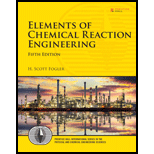
(a)
Interpretation:
The initial concentration of B
Concept Introduction:
In reversible reactions, the isothermal reactor design follows the same technique as used in irreversible reactions. The only exception is of the equilibrium conversion. It is defined as the maximum conversion which is achieved at the reaction temperature. It is denoted by
(b)
Interpretation:
The limiting reactant for the reaction is to be identified.
Concept Introduction:
The limiting reagent refers to the compound that is fully utilized after the completion of chemical reaction. It predicts the quantity of the product formed in a reaction.
(c)
Interpretation:
The exit concentration of B
Concept Introduction:
In reversible reactions, the isothermal reactor design follows the same technique as used in irreversible reactions. The only exception is of the equilibrium conversion. It is defined as the maximum conversion which is achieved at the reaction temperature. It is denoted by
(d)
Interpretation:
An expression for the rate
Concept introduction:
In reversible reactions, the isothermal reactor design follows the same technique as used in irreversible reactions. The only exception is of the equilibrium conversion. It is defined as the maximum conversion which is achieved at the reaction temperature. It is denoted by
(e)
Interpretation:
The equilibrium conversion is to be evaluated.
Concept Introduction:
In reversible reactions, the isothermal reactor design follows the same technique as used in irreversible reactions. The only exception is of the equilibrium conversion. It is defined as the maximum conversion which is achieved at the reaction temperature. It is denoted by
(f)
Interpretation:
The rate for the following conversion is to be calculated.
(1)
(2)
(3)
Concept Introduction:
In reversible reactions, the isothermal reactor design follows the same technique as used in irreversible reactions. The only exception is of the equilibrium conversion. It is defined as the maximum conversion which is achieved at the reaction temperature. It is denoted by
Want to see the full answer?
Check out a sample textbook solution
Chapter 4 Solutions
Elements of Chemical Reaction Engineering (5th Edition) (Prentice Hall International Series in the Physical and Chemical Engineering Sciences)
 Introduction to Chemical Engineering Thermodynami...Chemical EngineeringISBN:9781259696527Author:J.M. Smith Termodinamica en ingenieria quimica, Hendrick C Van Ness, Michael Abbott, Mark SwihartPublisher:McGraw-Hill Education
Introduction to Chemical Engineering Thermodynami...Chemical EngineeringISBN:9781259696527Author:J.M. Smith Termodinamica en ingenieria quimica, Hendrick C Van Ness, Michael Abbott, Mark SwihartPublisher:McGraw-Hill Education Elementary Principles of Chemical Processes, Bind...Chemical EngineeringISBN:9781118431221Author:Richard M. Felder, Ronald W. Rousseau, Lisa G. BullardPublisher:WILEY
Elementary Principles of Chemical Processes, Bind...Chemical EngineeringISBN:9781118431221Author:Richard M. Felder, Ronald W. Rousseau, Lisa G. BullardPublisher:WILEY Elements of Chemical Reaction Engineering (5th Ed...Chemical EngineeringISBN:9780133887518Author:H. Scott FoglerPublisher:Prentice Hall
Elements of Chemical Reaction Engineering (5th Ed...Chemical EngineeringISBN:9780133887518Author:H. Scott FoglerPublisher:Prentice Hall
 Industrial Plastics: Theory and ApplicationsChemical EngineeringISBN:9781285061238Author:Lokensgard, ErikPublisher:Delmar Cengage Learning
Industrial Plastics: Theory and ApplicationsChemical EngineeringISBN:9781285061238Author:Lokensgard, ErikPublisher:Delmar Cengage Learning Unit Operations of Chemical EngineeringChemical EngineeringISBN:9780072848236Author:Warren McCabe, Julian C. Smith, Peter HarriottPublisher:McGraw-Hill Companies, The
Unit Operations of Chemical EngineeringChemical EngineeringISBN:9780072848236Author:Warren McCabe, Julian C. Smith, Peter HarriottPublisher:McGraw-Hill Companies, The





